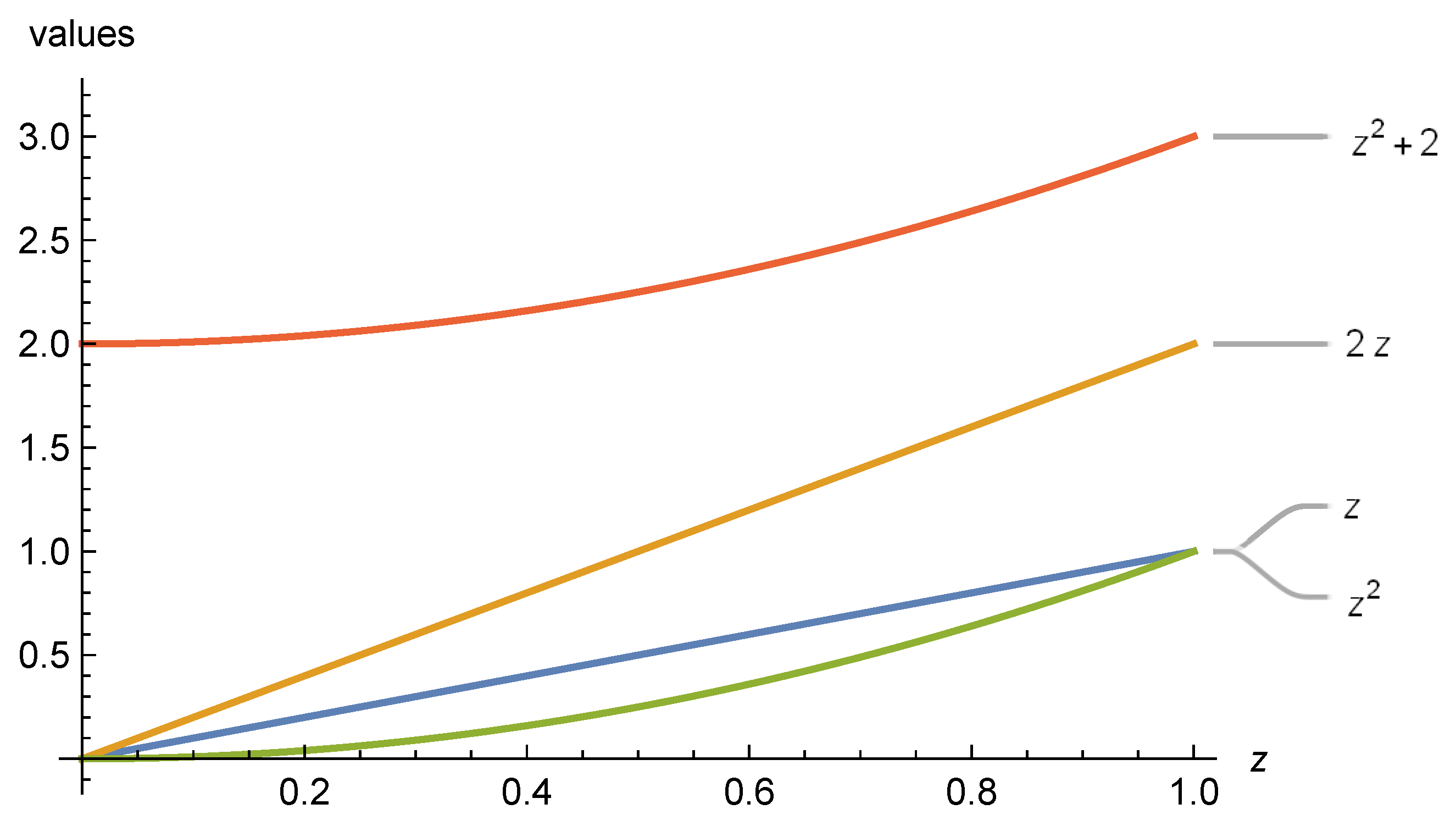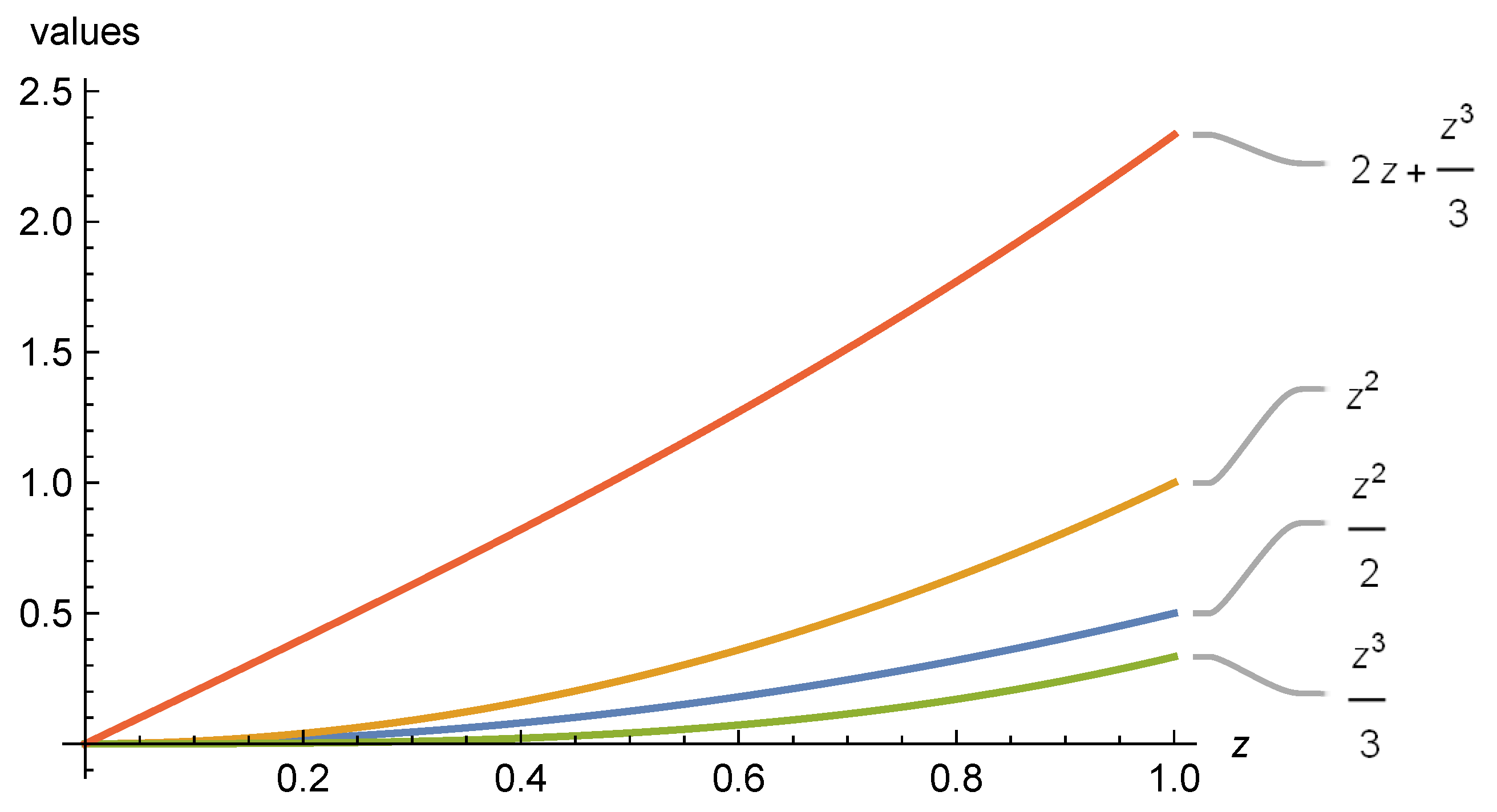Some New Generalizations of Integral Inequalities for Harmonical cr-(h1,h2)-Godunova–Levin Functions and Applications
Abstract
:1. Introduction
2. Preliminaries
- If , Definition 4 incorporates harmonic cr-P-function.
- If , , Definition 4 incorporates harmonic cr-h-convex function.
- If , , Definition 4 incorporates harmonic cr-h- function.
- If , , Definition 4 incorporates harmonic cr-s-convex function.
- If , , Definition 4 incorporates harmonic cr-s- function.
3. Main Results
4. Hermite–Hadamard-Type Inequality
- If , Theorem 5 becomes the result for harmonically cr-P-function:
- If , , Theorem 5 becomes the result for harmonically cr-convex function:
- If , , Theorem 5 becomes the result for harmonically cr-s-convex function:
5. Jensen-Type Inequality
- If , in this case, Theorem 9 incorporates output for harmonically cr- P-function:
- If , in this case, Theorem 9 incorporates output for harmonically cr-convex function:
- If , in this case, Theorem 9 incorporates output for harmonical cr-s-convex function:
6. Conclusions
Author Contributions
Funding
Institutional Review Board Statement
Informed Consent Statement
Data Availability Statement
Acknowledgments
Conflicts of Interest
References
- Sarikaya, M.Z.; Saglam, A.; Yildirim, H. On some Hadamard-type inequalities for h-convex functions. J. Math. Inequal. 2008, 2, 335–341. [Google Scholar] [CrossRef] [Green Version]
- Bombardelli, M.; Varoşanec, S. Properties of h-convex functions related to the Hermite-Hadamard-Fejer inequalities. Comput. Math. Appl. 2009, 58, 1869–1877. [Google Scholar] [CrossRef] [Green Version]
- Noor, M.A.; Noor, K.I.; Awan, M.U. A new Hermite-Hadamard type inequality for h-convex functions. Creat. Math. Inform. 2015, 2, 191–197. [Google Scholar]
- Zhang, S.; Shabbir, K.; Afzal, W.; Siao, H.; Lin, D. Hermite–Hadamard and Jensen-Type Inequalities via Riemann Integral Operator for a Generalized Class of Godunova–Levin Functions. J. Math. 2022, 2022, 3830324. [Google Scholar] [CrossRef]
- Dragomir, S.S.; Mond, B. Integral inequalities of Hadamard type for log-convex functions. Demonstr. Math. 1998, 31, 355–364. [Google Scholar] [CrossRef]
- Dragomir, S.S. Refinements of the Hermite-Hadamard integral inequality for log-convex functions. RGMIA Res. Rep. Collect. 2000, 3, 219–225. [Google Scholar]
- Niculescu, C.P. The Hermite–Hadamard inequality for log-convex functions. Nonlinear Anal. 2000, 3, 219–225. [Google Scholar] [CrossRef]
- Dragomir, S.S. On the Hadamard’s inequlality for convex functions on the co-ordinates in a rectangle from the plane. Taiwan. J. Math. 2001, 5, 775–788. [Google Scholar] [CrossRef]
- Zhao, D.; Zhao, G.; Ye, G.; Liu, W.; Dragomir, S.S. On Hermite–Hadamard-Type Inequalities for Coordinated h-Convex Interval-Valued Functions. Mathematics 2001, 9, 2352. [Google Scholar] [CrossRef]
- Faisal, S.; Khan, M.A.; Iqbal, S. Generalized Hermite-Hadamard-Mercer type inequalities via majorization. Filomat 2022, 36, 469–483. [Google Scholar] [CrossRef]
- Faisal, S.; Adil Khan, M.; Khan, T.U.; Saeed, T.; Alshehri, A.M.; Nwaeze, E.R. New “Conticrete” Hermite–Hadamard–Jensen–Mercer Fractional Inequalities. Symmetry 2022, 14, 294. [Google Scholar] [CrossRef]
- Dragomir, S.S. Inequalities of Hermite–Hadamard type for functions of selfadjoint operators and matrices. J. Math. Inequalities 2017, 11, 241–259. [Google Scholar] [CrossRef]
- Stojiljković, V.; Ramaswamy, R.; Ashour Abdelnaby, O.A.; Radenović, S. Riemann-Liouville Fractional Inclusions for Convex Functions Using Interval Valued Setting. Mathematics 2022, 10, 3491. [Google Scholar] [CrossRef]
- Stojiljković, V.; Ramaswamy, R.; Alshammari, F.; Ashour, O.A.; Alghazwani, M.L.H.; Radenović, S. Hermite–Hadamard Type Inequalities Involving (k-p) Fractional Operator for Various Types of Convex Functions. Fractal Fract. 2022, 6, 376. [Google Scholar] [CrossRef]
- Wang, H. Certain integral inequalities related to (φ,ϱα)–Lipschitzian mappings and generalized h–convexity on fractal sets. J. Nonlinear Funct. Anal. 2021, 2021, 12. [Google Scholar]
- Tam, N.; Wen, C.; Yao, J.; Yen, N. Structural convexity and ravines of quadratic functions. J. Appl. Numer. Optim. 2021, 3, 425–434. [Google Scholar]
- Moore, R.E. Interval Analysis; Prentice-Hall: Hoboken, NJ, USA, 1966. [Google Scholar]
- Snyder, J.M. Interval analysis for computer graphics. In Proceedings of the 19th Annual Conference on Computer Graphics and Interactive Techniques, Chicago, IL, USA, 27–31 July 1992; pp. 121–130. [Google Scholar]
- Rahman, M.S.; Shaikh, A.A.; Bhunia, A.K. Necessary and sufficient optimality conditions for non-linear unconstrained and constrained optimization problem with interval valued objective function. Comput. Ind. Eng. 2020, 147, 106634. [Google Scholar] [CrossRef]
- Qian, Y.; Liang, J.; Dang, C. Interval ordered information systems. Comput. Math. Appl. 2008, 56, 1994–2009. [Google Scholar] [CrossRef] [Green Version]
- de Weerdt, E.; Chu, Q.P.; Mulder, J.A. Neural network output optimization using interval analysis. IEEE Trans. Neural Netw. 2009, 20, 638–653. [Google Scholar] [CrossRef] [PubMed] [Green Version]
- Gao, W.; Song, C.; Tin-Loi, F. Probabilistic interval analysis for strucqrres with uncertainty. Struct. Saf. 2010, 32, 191–199. [Google Scholar] [CrossRef]
- Wang, X.; Wang, L.; Qiu, Z. A feasible implementation procedure for interval analysis method from measurement data. Appl. Math. Model. 2014, 38, 2377–2397. [Google Scholar] [CrossRef]
- Mizukoshi, M.T.; Lodwick, W.A. The interval eigenvalue problem using constraint interval analysis with an application to linear differential equations. Fuzzy Sets Syst. 2021, 419, 141–157. [Google Scholar] [CrossRef]
- Jiang, C.; Han, X.; Guan, F.J.; Li, Y.H. An uncertain structural optimization method based on nonlinear interval number programming and interval analysis method. Eng. Struct. 2007, 29, 3168–3177. [Google Scholar] [CrossRef]
- Wang, C.; Li, J.; Guo, P. The normalized interval regression model with outlier detection and its real-world application to house pricing problems. Fuzzy Sets Syst. 2015, 274, 109–123. [Google Scholar] [CrossRef]
- Chalco-Cano, Y.; Flores-Franulic, A.; Román-Flores, H. Ostrowski type inequalities for interval-valued functions using generalized Hukuhara derivative. Comput. Appl. Math. 2012, 31, 457–472. [Google Scholar]
- Costa, T.M.; Román-Flores, H.; Chalco-Cano, Y. Opial-type inequalities for interval-valued functions. Fuzzy Sets Syst. 2019, 358, 48–63. [Google Scholar] [CrossRef]
- Román-Flores, H.; Chalco-Cano, Y.; Lodwick, W. Some integral inequalities for interval-valued functions. Comput. Appl. Math. 2016, 37, 22–29. [Google Scholar] [CrossRef]
- Zhao, D.; An, T.; Ye, G.; Liu, W. New Jensen and Hermite-Hadamard type inequalities for h-convex interval-valued functions. J. Inequalities Appl. 2018, 2018, 302. [Google Scholar] [CrossRef] [Green Version]
- Zhao, D.; An, T.; Ye, G.; Torres, D.F. On Hermite-Hadamard type inequalities for harmonical h-convex interval-valued functions. arXiv 2019, arXiv:1911.06900. [Google Scholar]
- An, Y.; Ye, G.; Zhao, D.; Liu, W. Hermite-Hadamard type inequalities for interval (h 1, h 2)-convex functions. Mathematics 2019, 7, 436. [Google Scholar] [CrossRef] [Green Version]
- Liu, R.; Xu, R. Hermite-Hadamard type inequalities for harmonical (h1,h2) convex interval-valued functions. Math. Found. Comput. 2021, 4, 89. [Google Scholar] [CrossRef]
- Afzal, W.; Shabbir, K.; Botmart, T. Generalized version of Jensen and Hermite-Hadamard inequalities for interval-valued (h1, h2)-GL functions. AIMS Math. 2022, 7, 19372–19387. [Google Scholar] [CrossRef]
- Afzal, W.; Alb Lupaş, A.; Shabbir, K. Hermite–Hadamard and Jensen-Type Inequalities for Harmonical (h 1, h 2)-Godunova–Levin Interval-Valued Functions. Mathematics 2022, 10, 2970. [Google Scholar] [CrossRef]
- Bhunia, A.K.; Samanta, S.S. A study of interval metric and its application in multi-objective optimization with interval objectives. Comput. Ind. Eng. 2014, 74, 169–178. [Google Scholar] [CrossRef]
- Shi, F.; Ye, G.; Liu, W.; Zhao, D. cr-h-convexity and some inequalities for cr-h-convex function. Filomat 2022. submitted. [Google Scholar]
- Liu, W.; Shi, F.; Ye, G.; Zhao, D. The Properties of Harmonically cr-h-Convex Function and Its Applications. Mathematics 2022, 10, 2089. [Google Scholar] [CrossRef]
- Afzal, W.; Abbas, M.; Macías-Díaz, J.E.; Treanţă, S. Some H-Godunova–Levin Function Inequalities Using Center Radius (cr) Order Relation. Fractal Fract. 2022, 6, 518. [Google Scholar] [CrossRef]


Publisher’s Note: MDPI stays neutral with regard to jurisdictional claims in published maps and institutional affiliations. |
© 2022 by the authors. Licensee MDPI, Basel, Switzerland. This article is an open access article distributed under the terms and conditions of the Creative Commons Attribution (CC BY) license (https://creativecommons.org/licenses/by/4.0/).
Share and Cite
Saeed, T.; Afzal, W.; Abbas, M.; Treanţă, S.; De la Sen, M. Some New Generalizations of Integral Inequalities for Harmonical cr-(h1,h2)-Godunova–Levin Functions and Applications. Mathematics 2022, 10, 4540. https://doi.org/10.3390/math10234540
Saeed T, Afzal W, Abbas M, Treanţă S, De la Sen M. Some New Generalizations of Integral Inequalities for Harmonical cr-(h1,h2)-Godunova–Levin Functions and Applications. Mathematics. 2022; 10(23):4540. https://doi.org/10.3390/math10234540
Chicago/Turabian StyleSaeed, Tareq, Waqar Afzal, Mujahid Abbas, Savin Treanţă, and Manuel De la Sen. 2022. "Some New Generalizations of Integral Inequalities for Harmonical cr-(h1,h2)-Godunova–Levin Functions and Applications" Mathematics 10, no. 23: 4540. https://doi.org/10.3390/math10234540
APA StyleSaeed, T., Afzal, W., Abbas, M., Treanţă, S., & De la Sen, M. (2022). Some New Generalizations of Integral Inequalities for Harmonical cr-(h1,h2)-Godunova–Levin Functions and Applications. Mathematics, 10(23), 4540. https://doi.org/10.3390/math10234540







